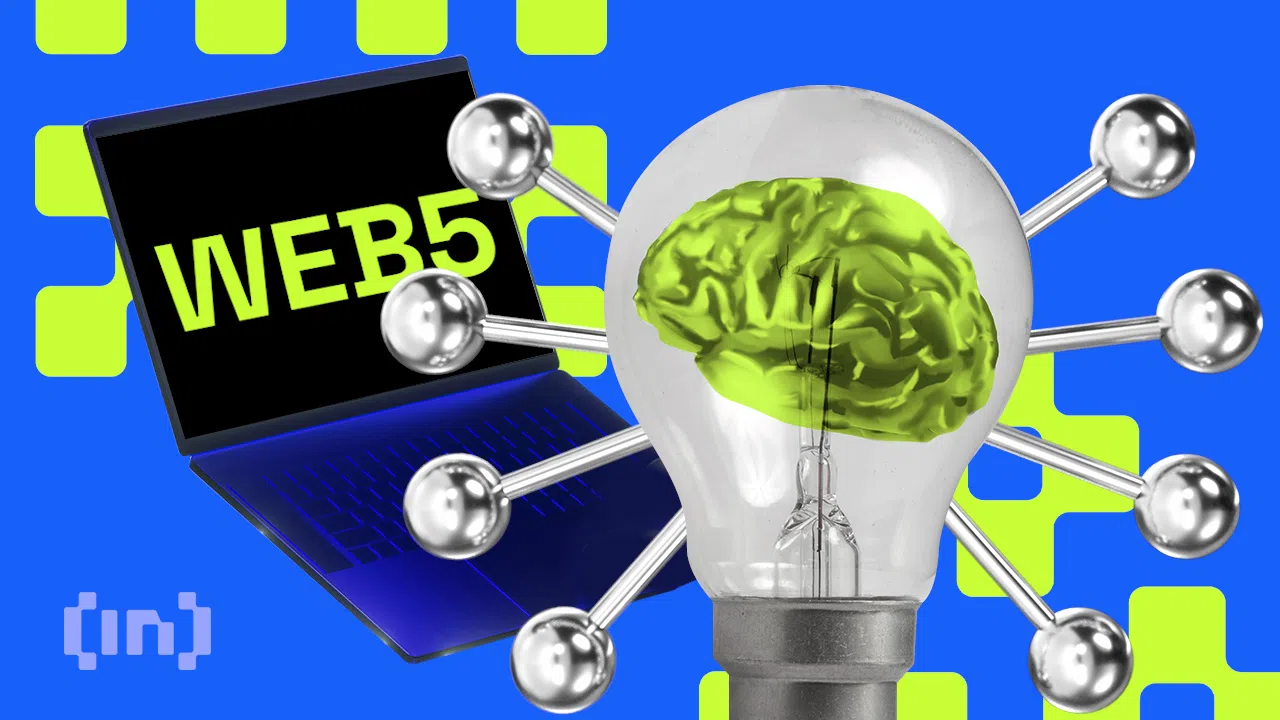Web5: Navigating the Next Frontier of Decentralized Web Evolution
 Evans Agina
Evans Agina
Take a deep breath, because the digital landscape is about to undergo a seismic shift. Web5 is not just a number; it's a revolutionary leap forward in the evolution of the web. You might be asking, 'What happened to Web4?' and 'What’s the difference between Web3 and Web5?'. Don't worry; we've got the answers, and the future is looking more decentralized and exciting than ever before.
What exactly is Web5?
Imagine a decentralized web playground sitting snugly on the bedrock of the Bitcoin network. What's its magic sauce, you ask? Well, Web5 throws the spotlight on three heavy-hitting pillars: Decentralized Identifiers, Verifiable Credentials, and those cool Decentralized Web Nodes. Now, why does this matter? Because it gives developers the keys to craft decentralized web apps that flip the script on who calls the shots. In the realm of Web 5.0, also dubbed Internet 5.0 for some extra flair, we're not just talking evolution; we're talking a revolution. Picture a digital melting pot where decentralization, blockchain, AI, IoT, and cryptocurrencies are all throwing a party. The mission? Hand the reins of power back to the people. Web 5.0 is like the superhero version of the internet, where developers wield the mighty tools of verifiable credentials and decentralized nodes to wrestle control from the big players and hand it back to us, the users. Buckle up; it's about to get interesting.
According to TBD, “the decentralized web platform(DWP) enables developers to write Decentralized Web Apps(DWAs) using Decentralized Identifiers(DIDs) and Decentralized Web Nodes(DWNs), returning ownership and control over identity and data to individuals <-- We are calling this Web5”.
So, let's crack the code on how TBD coined the term Web5. It's a bit like they threw Web3 (you know, the internet with blockchain-fueled smart contracts) into the mix with Web2 (those content hubs like Twitter or Facebook that keep things centralized). It's a straightforward math equation, really: 3 + 2 equals 5. Just like that, Web5 is born from blending the power of blockchain with the social landscapes of the internet. Easy peasy, right?
When Did Web5 Emerge?
So, let's rewind a bit to 2009 when the term "Web5" made its debut in a TED Talk by none other than Tim Berners-Lee, the genius behind the World Wide Web. Tim envisioned Web5 as an "open, connected, intelligent web," signaling the need for a more sophisticated and user-friendly online space.
Fast forward to 2022, and enter Jack Dorsey, the Twitter maestro turned CEO of Block (née Square). He, along with his TBD squad, took the Web5 concept for a spin and introduced a game-changing platform. This revamped Web5 is all about empowering dApps and protocols, building on the foundation laid down by Berners-Lee.
TBD throws down the gauntlet, arguing that the current web model is a bit of a data hostage situation, where users reluctantly hand over control to third-party bigwigs. With Web5, the game plan is different—it's about flipping the script to a decentralized setup, giving individuals the reins to their digital destinies.
What problem is Web5 aiming to solve?
So, here's the lowdown according to the presentation and website: the current Web2 setup doesn't play nice when it comes to users owning their own data or identity. It's like they're handed accounts by companies, and their precious data ends up stuck in these app silos. Jack Dorsey takes it up a notch, pointing out that Web3, despite its cool blockchain vibe, has fallen into the clutches of VC funds and isn't as decentralized as it should be, setting the stage for potential single points of failure. He even throws shade at Ethereum and Solana, citing network glitches when things get a bit too crowded.
In Dorsey's words, "The web democratized the exchange of information, but it’s missing a key layer: identity." He's not wrong. We're drowning in a sea of accounts and passwords we can't keep track of, and on today's web, our identity and data are practically held hostage by third parties.
Now, here comes the superhero moment. To birth a new breed of decentralized apps and protocols (enter tbDEX), ones that actually put individuals in the spotlight, users need a power-up. That power-up? Self-owned identity and taking back control over their data. It's like hitting the reset button on the whole web game. And if you're itching to know just how Web5 pulls off this digital liberation act, well, you're in for a thrilling ride.
How is Web 5.0 going to work?
Alright, so let's break down the key concepts that make up Web5. We've got:
1. Decentralized Web Nodes (DWNs):
These bad boys are at the heart of Web5, forming a distributed network of web nodes that creates the peer-to-peer magic. Imagine them as the superheroes of data storage and message relay. Web5 users run these DWNs, turning them into a mesh datastore network. In simple terms, DWNs are user-controlled nodes that store data and keep the communication flowing between users.
2. Decentralized Web Apps (DWAs):
Think of DWAs as the cool cousins of progressive web apps (PWAs) used by the big names like Twitter and Spotify. Unlike their centralized counterparts, DWAs are a fusion of a website and a mobile app, minus the need for a server to store data. The data's partying with the decentralized web nodes, and DWAs simply ask them for the info they need. If a user wants to keep things hush-hush, they're in control—deciding whether to grant access or keep the data under wraps.
3. Decentralized Identifiers (DIDs):
DIDs are the rockstars that make a pitstop on the public blockchain. Picture them as your self-generated, self-controlled VIP pass to the online world. With DIDs, users can voluntarily ID themselves without relying on a central bigwig. They're like your decentralized ID card, giving you the power to own your online identity. Plus, throw in some verifiable credentials, and you've got a digital identity that's truly yours.
4. Verifiable Credentials (VCs):
These buddies team up with DIDs to bring some serious street cred. VCs are like your digital certificates, attesting to your skills or qualifications. They add a layer of trust to your DID and, in turn, your digital identity. Together, DIDs and VCs pave the way for a self-sovereign identity in the digital realm...
And here's the kicker: the self-sovereign identity SDK is like the toolbox for developers, making it a breeze to cook up applications that ride on these self-sovereign identity principles. It's like giving developers the keys to the kingdom of digital identity. Cool, right?
COMPARING WEB5 TO WEB3
Alright, let's dissect the Web5 vision and its dance with Web3. While the overall vision aligns(Decentralization), there's a remix of the tune with a few notable distinctions. In the Web3 realm, applications strut their logic stuff in the form of smart contracts, finding their groove on a public blockchain like Ethereum. These Web3 applications, fondly known as dApps (decentralized applications), have their backend code chilling on a decentralized network, courtesy of that public blockchain.
Now, enter Web5. Here, we've got the cool cats known as decentralized web applications (DWAs). What sets them apart? Unlike their blockchain buddies in Web3, DWAs aren't hitching a ride on the blockchain train. They prefer to mingle with decentralized web nodes (DWNs), forming a peer-to-peer relay network that stands tall without leaning on any public blockchain. Picture this: DWAs shoot the breeze with DWNs, who, in turn, shoot the breeze with each other. And the best part? No need to wait on blockchain transactions for this chit-chat session.
In the Web3 neighborhood, the story is a bit different. Through dApps, users have a hotline to smart contracts on the blockchain, and every move is etched into the public blockchain's memory as a transaction. Whether it's a transaction on the main blockchain stage or a guest appearance on a Layer-2 protocol for scalability, every action gets its own spotlight. And let's not forget the tokens—fungible or non-fungible, they're the VIP passes to owning unique assets. Web5, on the other hand, plays a different game. No tokens take the stage here.
Now, where does the data crash? In Web5, users play host to their own data, storing it snugly on decentralized web nodes. Web3, being the adventurous type, opts for decentralized storage solutions or file systems like IPFS, tossing data into the peer-to-peer party mix. Different strokes for different webs, huh?
What major advantages does Web5 bring to the table?
Web 5.0 is currently in its crafting phase, and it'll be a while before we see it in action. As we eagerly await real-world scenarios, it's only natural to imagine the perks it might bring. However, it's crucial to also shine a light on the potential hiccups that could affect user experiences. Let's dive into the highlights of what Web 5.0 could offer and the challenges it might pose.
Pros:
1. Creative Expansion: The emotional intelligence angle of Web 5.0 could become a playground for users to amp up their creativity.
2. Revolutionizing Ecommerce Communication: Picture this—Web 5.0 injecting emotional intelligence into the ecommerce scene, paving the way for real-time, emotion-savvy communication. It could elevate user experiences and sprinkle a bit of magic on the ecommerce landscape.
3. Master of Identity and Data: One standout feature of Web 5.0 is the power it gives users—the power to rule their own identity and data kingdom. Unlike the current centralized web setups, Web 5.0 lets users decide how to wield their data scepter, offering a secure digital identity across various apps and services.
4. Bitcoin-Backed Security: Web 5.0 draws inspiration from the fortress of security—Bitcoin. By tapping into blockchain technology, it aspires to cloak users in the benefits of decentralization and cryptographic security.
Cons:
1. Work in Progress: The Web 5.0 project is still a canvas in the making, and the final masterpiece is a bit of a mystery. This element of unpredictability brings both excitement and potential challenges.
2. Adoption Ambition: The success of Web 5.0 is riding on one big condition—adoption. For the platform to spread its wings and soar, it needs a hefty dose of love and acceptance from users.
While Web 5.0 paints a tempting picture with its perks, it's essential to keep these factors and the ongoing evolution of the platform in mind as it dances its way toward reality.
Conclusion
Web5 stands at the forefront, poised to be the next frontier in the ongoing evolution of the World Wide Web. As it unfolds in its developmental cocoon, the allure and promise of Web5 are nothing short of mesmerizing. With its dedicated focus on empowering users, granting control over identity and data, embracing emotional intelligence, fostering advanced e-commerce communication, and fortifying security through blockchain technology, Web5 envisions a seismic shift in our online adventures.
Nevertheless, it's paramount to recognize that the success of this digital frontier, Web5, hinges on widespread adoption and the adept handling of developmental challenges. As we eagerly await the unveiling of Web5, we anticipate the dawn of a fresh era on the web—one that champions user-centricity, privacy, and fluid interactions, fundamentally reshaping our digital navigation and engagement.
Subscribe to my newsletter
Read articles from Evans Agina directly inside your inbox. Subscribe to the newsletter, and don't miss out.
Written by
